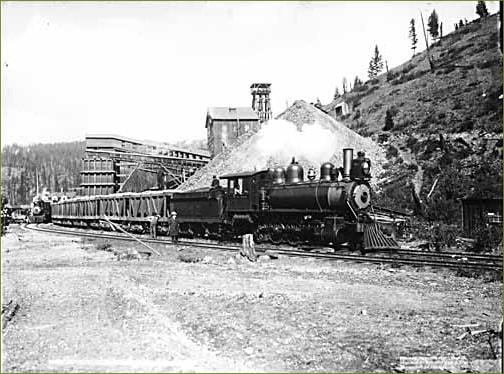The Mother Lode
BY: BG EDITOR

B. C. Copper Company's Mother Lode mine site, c. 1903
[ BC Archives, BCABS HP82672 ]
July, 2016 — GREENWOOD, BC (BG)
History Still Standing: A Guide to Historical Mine Sites of the Boundary Country by B.C. Ministry of Energy, Mines and Petroleum Resources offers a detailed description of the discovery, operation and eventual closure of the Mother Lode mine operation:
"Mother Lode was discovered in the Spring of 1891 about four kilometers west of Greenwood. Two prospectors were so intrigued by "a big copper stained blowout, standing out prominently and distinctly noticeable from all of the surrounding thinly timbered hill" that they decided to investigate further. A newspaper of the time reported that the lode stood out for 300 meters along the hill and rose to a height of 90 meters. On May 28, 1891 the Mother Lode (named for its size) was staked. Very little work was done on the claim until the summer of 1896, when the property was sold to Col. John Weir for $14,000. The Boundary Mines Company of New York was subsequently organized and a mining engineer was hired to develop the mine.
By this time the Mother Lode and other mines in the area had started to attract a great deal of attention. Even though the City of Greenwood was only a few kilometers away, partners Colin Scott McRae and Donald McLaren saw an opportunity for a new town site near the Mother Lode. Together they preempted a 259-hectar parcel of land and in 1899 the new town of Deadwood was developed. By the first week of February 1900, 45 lots were sold for up to $150 each. Despite this initial enthusiasm Deadwood never amounted to much, with the population reaching less than 100. The majority of miners and their families lived at the Mother Lode mine site, which was home for about 400 people.

Mother Lode Mine in Greenwood
[ Vancouver Public Library, VPL 9833 ]
The ore was mined underground at the Mother Lode on levels with pillars to hold up the rock overhead. Surface ore was taken from six quarries forming an enormous "glory hole". By the end of 1905, 752,431 tonnes of ore were shipped to the smelter. In 1909, even with a four-month stoppage due to a coal miners' strike, the mine set a record of 349,272 tonnes. The Mother Lode continued to be worthy of its name!
Then in August 1913 a blast, which was claimed to be the largest in mining history, was set off at the Mother Lode. In all, 4834 holes of an average depth of 4.5 meters were driven and filled with explosives. The blast required 22,475 kilograms of 40 percent, anti-freezing powder to charge the holes. The holes were then wired in a series of forty to a group, using 26, 532 metres of electric wire. To prevent any possibility of accident, everybody was taken off the hill and three safety-switches were placed in the circuit, all of which had to be connected before the spark could pass. Approximately 39,000 tonnes of ore were broken but this momentous event also sounded the death knell of the mine. The already low grade ore was further diluted with waste and the mine became hazardous and expensive to work. The rim of the "glory hole" collapsed, sealing many of the chutes through which ore was removed.

Canadian Pacific Railway Locomotive #952 at Mother Lode Mine, c. 1903
[ Vancouver Public Library, VPL 1782 ]
Today the Deadwood and Mother Lode sites have been reclaimed by nature. On the drive to the Mother Lode a visitor will go by the field that marks the remains of the Deadwood town site. At the end of the road is the enormous "glory hole". Please stay on the road to view it, as the open pits are privately owned and very dangerous."
Prepared with the assistance of the Greenwood District Mining Heritage Committee







